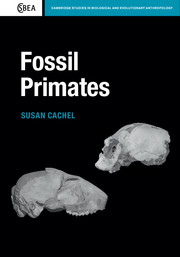Book contents
- Frontmatter
- Dedication
- Contents
- Acknowledgments
- Preface
- 1 Introduction: primates in evolutionary time
- 2 Primate taxonomy
- 3 Fossils and fossilization
- 4 The world of the past
- 5 The lifeways of extinct animals
- 6 Evolutionary processes and the pattern of primate evolution
- 7 Primate origins
- 8 The Paleocene primate radiation
- 9 The Eocene primate radiation
- 10 The Malagasy primate radiation
- 11 The Oligocene bottleneck
- 12 Rise of the anthropoids
- 13 The platyrrhine radiation
- 14 The Miocene hominoid radiation
- 15 The cercopithecoid radiation
- 16 Late Cenozoic climate changes
- 17 Conclusions
- References
- Index
16 - Late Cenozoic climate changes
Published online by Cambridge University Press: 05 April 2015
- Frontmatter
- Dedication
- Contents
- Acknowledgments
- Preface
- 1 Introduction: primates in evolutionary time
- 2 Primate taxonomy
- 3 Fossils and fossilization
- 4 The world of the past
- 5 The lifeways of extinct animals
- 6 Evolutionary processes and the pattern of primate evolution
- 7 Primate origins
- 8 The Paleocene primate radiation
- 9 The Eocene primate radiation
- 10 The Malagasy primate radiation
- 11 The Oligocene bottleneck
- 12 Rise of the anthropoids
- 13 The platyrrhine radiation
- 14 The Miocene hominoid radiation
- 15 The cercopithecoid radiation
- 16 Late Cenozoic climate changes
- 17 Conclusions
- References
- Index
Summary
Major climatic oscillations that are characteristic of the Pleistocene actually begin far earlier, in the Late Cenozoic. Seasonality becomes more pronounced. Temperature and precipitation are no longer equably distributed throughout the year. Aridity increases, and tree cover is lost in many places. Plants that use the C4 photosynthetic pathway (largely tropical grasses that can tolerate prolonged drought) spread very widely, heralding the shift to a “C4 world” (Cerling & Ehleringer, 2000). This cooler and drier global climate foreshadows the outright appearance of continental glaciation during the Pleistocene.
Geochemical signatures of atmospheric carbon dioxide have been followed over the last 20 million years using boron/calcium ratios from fossil foraminifera. During the Middle Miocene (14–10 mya), atmospheric carbon dioxide was roughly similar to that of the present, even though global temperatures were about 3–6°C warmer, and sea levels were about 25–40 m higher (Tripati et al., 2009). A major Late Miocene land mammal extinction event termed the “Vallesian Crisis” occurred in Western and Central Europe at the end of the Vallesian Land Mammal Stage beginning 9.6 mya. Many rhinoceroses and tapirs disappeared, and pig diversity declined. A turnover occurred among the rodents. After the Vallesian Crisis, murid rodents, which include modern mice and rats, become the dominant rodents in Late Miocene communities. Atmospheric carbon dioxide fell during the Late Miocene. Ice sheets in West Antarctica and Greenland grew when atmospheric carbon dioxide fell significantly below modern levels. Glacial conditions thus intensify during the Late Miocene (after ~10 mya) and Late Pliocene (3.3–2.4 mya).
- Type
- Chapter
- Information
- Fossil Primates , pp. 255 - 258Publisher: Cambridge University PressPrint publication year: 2015



